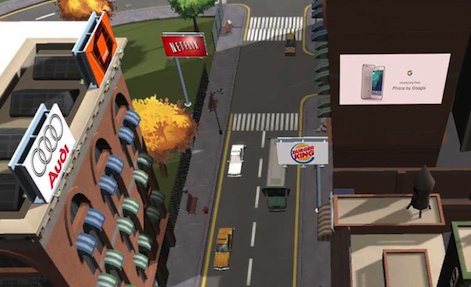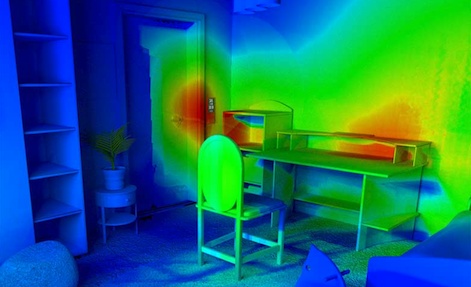Finding ways to monetise games remains a hot topic. But while mobile gaming is a mature market, one where in-app purchases and rewarded videos are common, people are still figuring out how to properly make money from VR entertainment.
A maximum triple-A price point isn't always the way, so a number of companies have sprung up to solve the problem of putting adverts into VR games to help creators pay for their work.
Advir is a new firm that acts as a sort of broker between the game developer and the advertisers, supplying a toolkit that helps companies place billboards inside their virtual worlds. They're also founders of the VR/AR Pledge, a commitment against intrusive ads. How do they square that circle?
We met up with the founder and CEO of Advir, Samuel Huber, during Develop in Brighton this month, to quiz him on his company's plans and on the state of VR advertising in general.
How did Advir get started?
I used to work in Formula One for about two years and then left to do my own thing - I started developing mobile games! I sold one to a larger publisher, and then I got into e-commerce. So I was running an e-commerce start-up. I kind of mixed both of the worlds. With e-commerce being effectively advertising, I worked with a lot of brand agencies, starting to see that they were looking at what was coming next. I’m a big tech enthusiast as well. So I started looking at VR and thinking, ‘Hey, the geometry of this media is really interesting. We have a lot more flexibility on a stream like this to story-tell. Let’s try to find a way to make it happen.’ That was about a year ago. We raised seed funding in February. So that’s where this thing actually started.
We have more demand than supply... it’s probably one-and-a-half to two years away.
How far are we from mainstream adoption of VR?
There’s about five million devices in circulation, excluding Cardboard, which isn’t really counted because they’re given away for free. But there’s like five million people who actually want to buy devices.
So the interesting thing is, as part of the advertising industry where we have demands from the advertisers and supply inventories – at the moment, we have more demand than supply. So we have advertisers that say, ‘Hey, we want to reach a million people and have 10 million impressions in a month.’ Well, we can’t, because there’s not enough people! So we’re really limited by the supply side.
What it means is, the business model is proven; we just need mass adoption to happen. And according to market research and also our own data, it’s probably one-and-a-half to two years away from really having a VR headset… not every home, but in a decent amount. We estimate around 30 to 40 million headsets. We also support AR and that’s where the main mass adoption will start from.

Advertising is the best business model to monetise VR today.
Let’s talk a bit about advertising in VR. You set out to address a certain challenge. What did you observe that needed a solution you could deliver?
It’s about helping the person monetise. It happens that advertising is the best business model to monetise VR today. We think that e-commerce and direct purchase are going to be another one and how we’re structuring Advir is actually profiting on the inventory – having these areas of the game where we can put an ad, but you can also put a product. So it’s really having these zones where developers can do anything to monetise. We didn’t take the advertising angle and say, ‘Hey, brands might want to reach their audience in VR.’ It’s not that. It’s helping VR and AR developers monetise.

We connect to big advertisers and use their existing creative and render that properly in VR.
Let’s say a developer has made a first-person adventure game for VR. They come to you – how do you work with them?
If they go to our website, they can download our Unity package (I’m assuming the game is made with Unity). They install that. It’s all automatic. It tells you what to do. You basically have shapes that you can then drag and drop. This is your inventory. So you create your inventory. You give the person the control of where the ads or the placement will appear. So you can put something on a TV, and they can play a video there. Or a poster, or a cube somewhere that will be replaced by a 3D model of a product. And then they can filter out what type of advertisers they want by getting sports or entertainment or food, whatever it is. Press a button, then they build their game and don’t have to touch it ever again.
Then we can manage this directly from the web interface. And we connect that to third-parties. So we don’t handle the inventory ourselves, but we connect to AOL, Yahoo, AdMob - big advertisers that already work on the web and we’re able to use their existing creative and render that properly in VR.

What sort of feedback do developers get? Are they able to see how well an ad is performing?
Yeah. We’re the centre-piece of a puzzle, where we connect to other third-parties. So we connect to cognitiveVR, which is an analytics service for VR. They’ll have access to heat maps and can aggregate where people have looked on average. They can really understand if there are zones that people never go to, for example. It also gives feedback for where to put the ads to get the best return on investment.

We consider ourselves as a virtual estate company. We want to own virtual spaces and then sell it to advertisers.
What’s your unique proposition, compared to other people in this adverting space right now?
We consider ourselves as a virtual estate company. So you can see the real estate companies, like JCDecaux with all their billboards and we want to do the same thing. We want to own virtual spaces and then sell it to advertisers.
Instead of building the whole integration where we would be our own demand side and go to advertisers and say, ‘Hey, come and spend money with us,’ we don’t do any of that. We just give our tool to developers to create an inventory, and then we connect to third-parties. So we have a partnership with, Yahoo, AOL and others. We’re the first VR technology that gives them access to a VR inventory. At the moment, the other guys, they’re building the whole thing, if that makes sense.
We want to meet developers [at shows like Develop] and get them to integrate the technology. It’s free. It gives them access to analytics and all these tools and they can connect any other service on top. By having us, they’re not restricted to using our advertisers. They can bring their own advertisers and just resell that inventory. That’s what we’re here for.
How do you make money out of it?
We take a 15% cut on every impression, basically.
Are there still areas of your service where you’re building?
Absolutely. Right now it’s in beta, with a couple of developers. We have about 100 on our waiting list. First of all, we want to develop a version for Unreal. That’s top of our priorities. The other thing is, we’re building extra tools for other types of monetisation.
We’re doing a thing, for example, which is called a bookmark. So it keeps track of all the ads that you see, and then later on you can access the website, but it doesn’t interrupt your experience. We’re trying to go closer for a conversion model than purely an awareness model.

Where do you see the opportunities in AR?
It’s hard to say long-term. Right now, there is literally no real content in AR. At the beginning, it’s going to go quicker because we already have the device. It’s going to grow through smartphones. So it’s just software updates, and all of a sudden you have access to AR.
The advertising opportunities in AR are the same, but layering ad inventory on the real world?
There are different approaches. It’s kind of an unlimited inventory because we could put ads everywhere. So as a way to mitigate that, we actually work with out-of-home advertisers. At JCDecaux, they could make this work with real inventory, and we could augment these existing ads through a phone. Right? Instead of putting an ad everywhere and anywhere. That’s our approach.

Be careful with the hype... if you talk to a 'normal' person, most of them confuse VR and AR.
What’s the biggest lesson that you’ve learned since you’ve started?
Two things. The first one is: be careful with the hype. We always think that tomorrow VR is going to be mainstream, with all these big companies pushing it. But still, if you go out of these conferences and you talk to a 'normal' person, most of them haven’t even heard of it. They confuse VR and AR, which is crazy, right, if you think about it. So it’s not there yet.
And the second thing is that advertising has a really bad name because of internet advertising and the intrusiveness - and the fact the targeting is not always perfect, so you see things you’ve already bought and so on. So that’s also something we have to work against and educate people that a change is possible.
So this is why we created this pledge: an initiative that we started with a company called Retinad in Canada. They do analytics. We basically decided to create this moral commitment that any company can join. You can kind of wear it as a badge, like: I commit for a future without intrusive ads. It’s also branching into the advertising committee of the VR Association, which is there to define standards for advertising.
What defines an intrusive ad?
An intrusive ad is just one that interrupts your experience or is not relevant. So we have rules in the pledge that you have to respect. The main one is: do not intrude. Respect the story. So it can be non-intrusive, but if it stands out completely, it has to make sense. Artificial intelligence is going to be one of the main drivers of making all the ads relevant. What we think is that, if the targeting is perfect - if as an advertiser, I know what you want and when you want it - then there’s no more spam. Because if you need shoes and you see an ad for shoes, then it’s great. You’re not going to be annoyed by it.

You can connect on a much deeper level... it’s a better way of visualising.
What makes you optimistic about the future of VR?
VR games are a much better way to immerse people. I think when we consume content, we like to be really close to it and really feel like we are part of it. So I think for entertainment in games, it’s just a perfect example.
Similarly, for social VR as well, you can really connect on a much deeper level. And then all the enterprise stuff like training; it’s just a better way of visualising. I think we live in 3D and seeing everything in 2D is very restrictive. So I think VR opens up another dimension.
To meet more people working to solve these kind of problems in VR, be sure to get your tickets to our own XR Connects event, which next takes place in Helsinki in September, followed by London in January.













